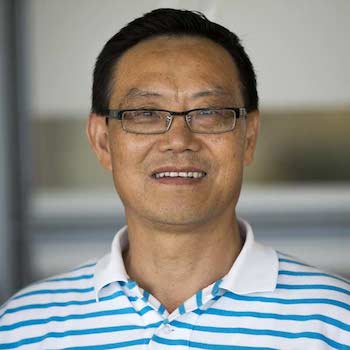Location
3006 Phoenix
Phone
Research Interests
- Fundamental understanding of ion-solid interaction and radiation effects in ceramics and reactor materials, interfacial and nanostructure evolution of semiconductors, radiation detector materials, and development and application of multi-scale computer simulation for materials modeling.
- Multi-scale computer simulations of microstructure evolution of solids under irradiation employing various computational methods, including density functional theory (DFT), ab initio molecular dynamics, time-dependent DFT, and tight-binding calculations, molecular dynamics simulations, long-time dynamics, kinetic Monte Carlo, and cluster dynamics.
- Degradation of spent nuclear fuel canisters
- Swift heavy ion damage in materials
- Ceramics for nuclear waste forms, fuels and fusion reactor applications
- Radiation response and signal generation in detector materials
Development of high performance ODS alloys
The research employs coordinated experiments to study swelling, radiation hardening and changes in mechanical properties not only of these ODS alloys, but also further-optimized ODS candidates resulting from these first-round studies. The project will identify key factors influencing radiation tolerance of new ODS alloys for further property optimization. To gain atomic scale understanding, the research integrates these experiments with modeling capabilities, including molecular dynamics and dislocation dynamics simulations to understand the roles of yttria and other dispersoids as well as their various dispersion modes on both microstructural changes and mechanical property changes.
Atomistic- and Meso-Scale Computational Simulations for Developing Multi-Timescale Theory for Radiation Degradation in Electronic and Optoelectronic Devices
The research is to simulate atomistic- and meso-scale behavior of defect evolutions in compound semiconductors, including ultrafast displacement cascade, intermediate defect stabilization and cluster formation, as well as slow defect reaction and migration. The fundamental mechanisms and knowledge gained from atomic- and meso-scale simulations will be input into rate-diffusion theory as initial conditions to calculate the steady-state distribution of point defects in a mesoscopic layered-structured system, thus allowing the development of a multi-timescale theory to study radiation degradation in electronic and optoelectronic devices. The long‑term goal is developing a fundamental understanding of defects and defect processes in compound semiconductors, including defect/property relationships, the effects of defects on transport processes, the aggregation of defects to form complex nanostructures, and the development of predictive models of behavior.
Computational Capability for Studying Pulse Shape Discrimination of Scintillator Materials
The research collaborates with the researchers at Pacific Northwest National Laboratory to identify and understand the elementary processes that give rise to the measurable performance characteristics of scintillator materials. Through the development of a firm theoretical understanding of scintillator physics, the research will provide a pathway to optimize current scintillators and lead to the science-driven candidate search for new scintillator materials. The application of these capabilities to predict the pulse shape discrimination capability of scintillator materials will be explored.
Materials & Radiation Effects
News
Education
University of Liverpool, UK
Ph.D. Materials Science ’95
Lanzhou University, China
M.S. Condensed Matter Physics ’87
Lanzhou University, China
B.S. Physics ’83
Professional Service
- 2014-present: Professor, University of Michigan, Nuclear Engineering & Radiological Sciences
- 2010-2014: Adjunct Professor, Washington State University
- 2008-2014: Chief Scientist, Pacific Northwest National Laboratory
- 2004-2008: Senior Research Scientist IV, Pacific Northwest National Laboratory
- 2001-2003: Senior Research Scientist III, Pacific Northwest National Laboratory
- 2000-2001: Research Scientist, Pacific Northwest National Laboratory
- 1997-1999: Senior Research Fellow, University of Liverpool, UK, Materials Science and Engineering
- 1994-1997: Research Associate, University of Liverpool, UK
- 1991-1994: Research Assistant (PhD study), University of Liverpool, UK
- 1987-1990: Lecturer, Lanzhou University, China
OTHER PROFESSIONAL ACTIVITIES
- International Committee for Computer Simulations of Radiation Effects in Solids
- Program Committee: SPIE Hard X-Ray, Gamma-Ray, and Neutron Detector Physics
- General Secretariat, 16th International Conference on Fusion Reactor Materials
- Guest Senior Scientist, Institute of Ion Beam Physics and Materials Research, Forschungs Zentrum Rossendorf, Germany, 2002-2007
- Academic Editor, American Institute of Physics Advances (2010-2013); Editorial Board, Dataset Papers in Physics, Atomic and Molecular Physics (2011-present) and Conference Papers in Physics (2012-present)
Honors and Awards
- Selected FZD (Forschungs zentrum Dresden-Rossendorf) Fellow, Institute of Ion Beam
- Physics and Materials Research, Forschungs Zentrum Rossendorf, Germany (2008-2009)
- Outstanding Research Award of Basic Energy Science, U.S. Department of Energy (2004)
- Outstanding Performance Awards, Pacific Northwest National Laboratory (2001-2003)
